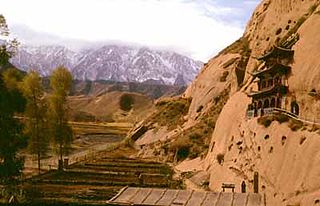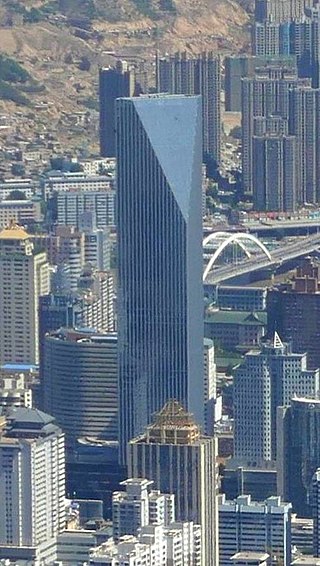
The Subei Mongol Autonomous County is an autonomous county within the prefecture-level city of Jiuquan in the northwest of Gansu Province, China, bordering Xinjiang to the west, Qinghai Province to the southeast and Mongolia's Govi-Altai Province to the north. Containing the northernmost point in Gansu, Subei is split into two non-contiguous sections and has an area of 66,748 km2 (25,772 sq mi) and had approximately 13,046 inhabitants in 2000. To the east it shares a border with Ejin Banner, Alxa League, Inner Mongolia.

Jingchuan County is county under jurisdiction of the prefecture-level city of Pingliang, in the east of Gansu Province, China, bordering Shaanxi Province to the southeast. It has a land area of 1,486 square kilometers. The county is named after the Jing River. In 2020 it had a population of 356,200, over 300,000 of whom in the rural area.

Wen County or Wenxian is a county under the administration of the prefecture-level city of Longnan, in the southeast of Gansu province, China, bordering Sichuan province to the south and west. It has a land area of 4,994 square kilometers, and a population of 241,000 (2019), notably having the largest population of Baima people.

Gangu County is a county in the southeast of Gansu province, the People's Republic of China. It is under the administration of Tianshui City and is the most populous county in Gansu. Its postal code is 741200, and in 1999 its population was 570,318 people.

Maiji District is a district of the prefecture-level city of Tianshui in the southeast of Gansu Province, China, bordering Shaanxi Province to the east. It is best known for, and named after, the Maijishan Grottoes. Before 2005 it was called Beidao District.

Jingtai County is a county in the middle of Gansu Province, bordering Inner Mongolia to the north. It is under the administration of Baiyin City and located at its northwest end. Covering an area of 5,483 square kilometres (2,117 sq mi), it governs 8 towns and 3 townships, which then in turn govern 15 residential communities and 135 administrative villages. Its postal code is 730400, and its population as of the 2010 Chinese Census was 225,755 people, which the county government reports has grown to about 238,900 as of 2019.

Honggu District is one of five districts of the prefecture-level city of Lanzhou, the capital of Gansu Province, Northwest China. Although administratively part of Lanzhou, it is not part of the continuous built-up area of the city, and is located roughly equidistant between Lanzhou and Xining. Directly across the Huangshui River lies Minhe Hui and Tu Autonomous County in Qinghai.

Wudu District is a district and the political and cultural centre of Longnan, Gansu province, China. It borders the provinces of Shaanxi and Sichuan to the southeast. It has a population of 590,000, of which 110,000 live in the urban area.

Lanzhou Metro or Lanzhou Rail Transit is a rapid transit system in Lanzhou, Gansu, China.
Gongxingdun Airport also called Lanzhou Donggang Airport (兰州东岗机场) was an airport in Gongxingdun township, Chengguan District, Lanzhou, Gansu, China. It was the primary airport of Lanzhou from the 1930s to 1970.

China National Highway 341 will run from Jiaonan in Shandong to Haiyan in Qinghai. It is one of the new trunk highways proposed in the China National Highway Network Planning.
Longcheng is a town of Qin'an County, Tianshui, Gansu, China. It is located about 45 km from the seat of Qin'an county. In 2012 it had a population of 32,000, of which around 10,000 lived in the town's main village.

Honglou Times Square is a 313 metres (1,026.9 ft) tall skyscraper in Lanzhou, Gansu, China. Construction started in 2012 and was completed in 2018. It is the tallest building in Gansu.
Huajialing Town is a township-level administrative unit under the jurisdiction of Tongwei County, Dingxi City, Gansu Province, People's Republic of China. It is located roughly equidistant from the seats of Tongwei, Huining and Anding.











